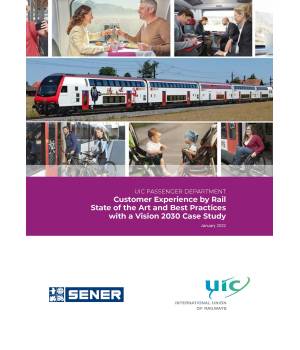
Customer Experience by Rail: State of the Art and Best Practices with a Vision 2030 Case Study
Customer Experience is becoming a relevant element of differentiation and a must to become the first option among other modes of transport. The railway community is collaborating to improve their overall CX by laying the foundation for tools and measures for customer experience management.
The priorities of this document are to provide an overview on best practices on Customer Experience on a global scale, as well as making an analysis of future challenges, to provide a guide addressed to railway companies, to advise on how put the customer in the heart of the process.
A customer-centric approach means using service as a key differentiator; interacting with customers based on their needs and their value to the organization; adopting a fact-based approach to decisions using customer data as a primary source of insight; embracing new channels; and building a customer-focused culture.
The UIC Customer Experience Management Platform (CEMP) project´s objective is to improve the overall Customer Experience knowledge in the railway sector and thus increasing its attractiveness and profitability with the final objective of fostering a seamless Customer Experience across railway operators and across different modes of transport answering to the vision of the Railway Sector Vision “Challenge 2050” regarding “Value for money Services”.
Since 2020, the members of the UIC Customer Experience Platform have exchanged information about how they tackled different topics related to customer experience in regular meetings in which also experts have been invited to share their knowledge to look into specific matters as rolling stock or stations.
The vision and goals are all underpinned by the steps taken in the core rail system fields of policy (what needs to be done), technology (developing the tools to enable it to be done) and providing services (what the user perceives and receives when a customer of rail).
These apply across the whole vision, overlap and come together to enhance the overall attractiveness of rail to the customer.
Public transport is changing rapidly, and new forms of societal organisation and technologies are emerging, influence and redefine the needs and requirements of the modern customers of the public transport sector.
Railway transport sector has historically been more concentrated in the technological challenges inherent to the development of rail infrastructures and services than in the customer experience. Nevertheless, nowadays the World is facing environmental and health challenges that impale railways to improve their efforts in improving the perception of rail as a convenient way of travel in terms of safety and security as well as in terms of comfort.
This should give a base for a renewal of a sustainable economic growth of rail as backbone of short and long-distance public transport and customer experience is key to foster rail as pillar of sustainable mobility in the post-Covid-19 reality.
Public Transport is on the brink of a new era of “smart mobility” of interconnectivity which is affecting if not disrupting operations; social media and networks, mobile/smart phone applications, smart travel information systems, Open Data / Open Service, Big Data, real-time inter-modal journey planning, transport management centres or systems controlling multimodality and complexity, etc., are revolutionizing passenger experience and put the operators’ and authorities’ operations to a serious test.
| Author | UIC |
| ISBN | 978-2-7461-3171-2 |
| Pages | 164 |
Data sheet
- Language
- English
- Format
- Downloadable
- Edition
- Ed. no.1
- Edition date
- 01/01/2022
- Publication date
- 26/06/2023
- Page number
- 164
- sku
- 5-22012E-PDF
- Reference
- 5-22012E
 Cookie preferences
Cookie preferences

